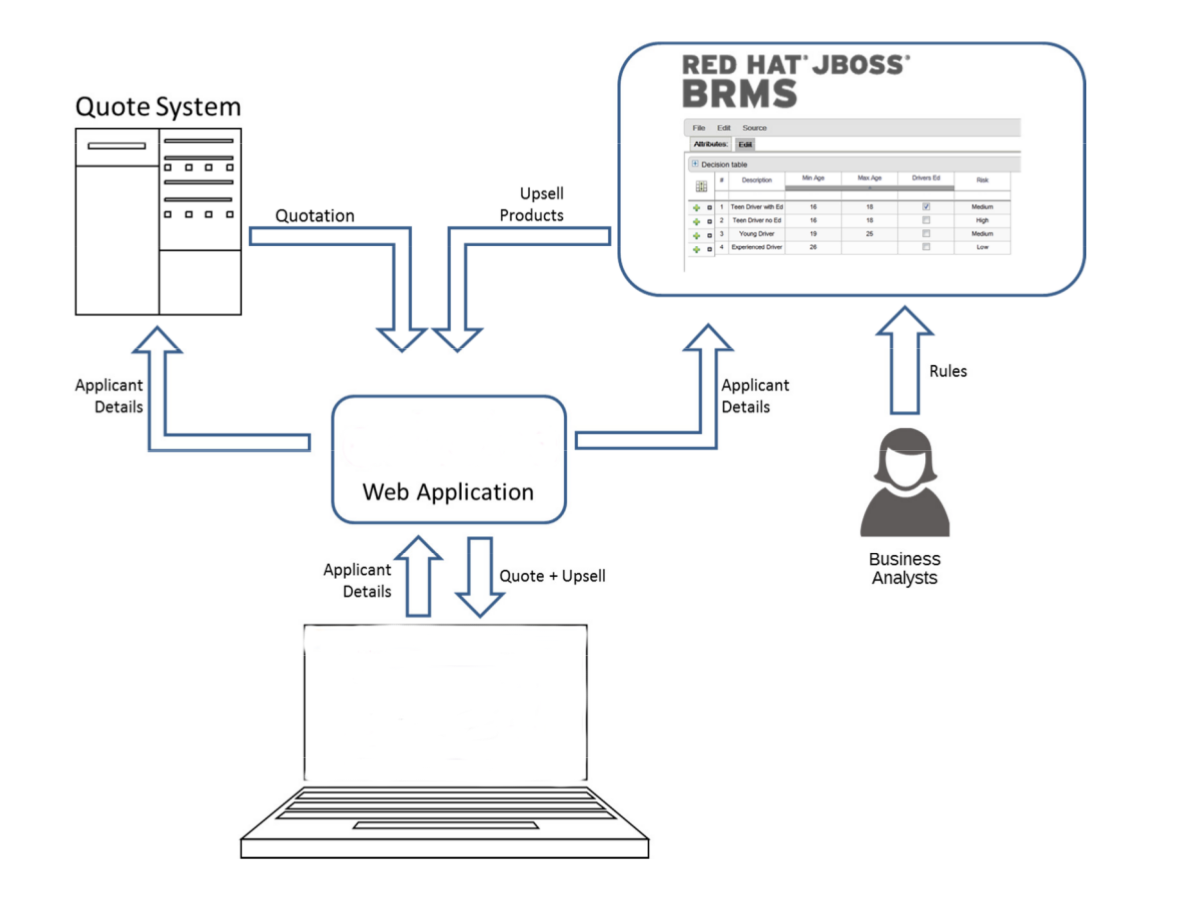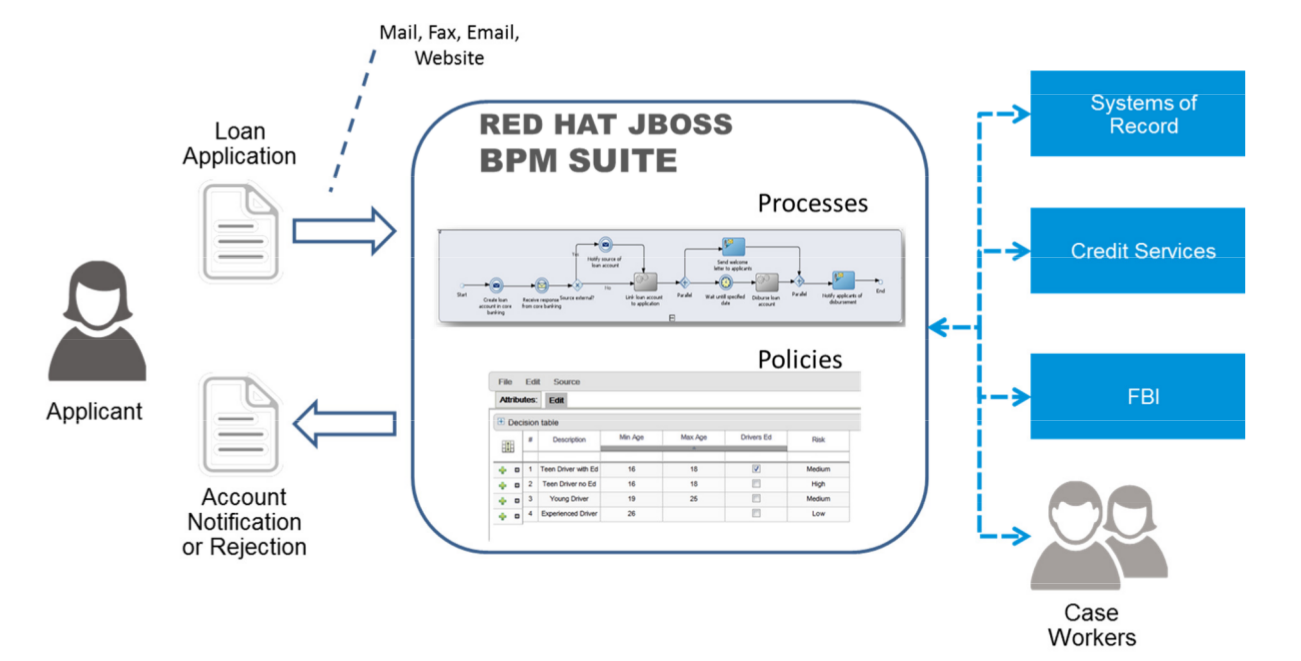
Red Hat JBoss BRMS is an open source business rule management system that provides rules development, access, change, and management capabilities. In today’s world, when IT organizations consistently face changes in terms of policies, new products, government imposed regulations, a system like JBoss BRMS makes it easy by separating business logic from the underlying code. It includes a rule engine, a rules development environment, a management system, and a repository. It allows both developers and business analysts to view, manage, and verify business rules as they are executed within an IT application infrastructure.
Red Hat JBoss BRMS can be executed in any Java EE-compliant container. It supports an open choice of authoring and management consoles and language and decision table inputs.
Red Hat JBoss BRMS comprises the following components:
The Red Hat JBoss BRMS provides the following key features:
Red Hat JBoss BPM Suite is an open source business process management system that combines business process management and business rules management. Red Hat JBoss BRMS offers tools to author rules and business processes, but does not provide tools to start or manage the business processes. Red Hat JBoss BPM Suite includes all the Red Hat JBoss BRMS functionality, with additional capabilities of business activity monitoring, starting business processes, and managing tasks using Business Central. Red Hat JBoss BPM Suite also provides a central repository to store rules and processes.
The Red Hat JBoss BPM Suite comprises the following components:
To execute your business processes, you can use Business Central web application that bundles the execution engine, enabling a ready-to-use process execution environment. Alternatively, you can create your own execution server and embed the Red Hat JBoss BPM Suite and Red Hat JBoss BRMS libraries with your application using Java EE. For example, if you are developing a web application, include the Red Hat JBoss BPM Suite or Red Hat JBoss BRMS libraries in the WEB-INF/lib folder of your application.
Red Hat JBoss BPM Suite provides the following features:
For a list of supported containers and configurations, see section Supported Platforms of Red Hat JBoss BPM Suite Installation Guide .
The kie-api is a fully supported API and it is the recommended way to interact with your project. For further information about API supportability, see Knowledgebase article What Are the Public and Internal APIs for BPM Suite and BRMS 6?.
Red Hat JBoss BRMS comprises a high performance rule engine, a rule repository, easy to use rule authoring tools, and complex event processing rule engine extensions. The following use case describes how these features of Red Hat JBoss BRMS are implemented in insurance industry.
The consumer insurance market is extremely competitive, and it is imperative that customers receive efficient, competitive, and comprehensive services when visiting an online insurance quotation solution. An insurance provider increased revenue from their online quotation solution by upselling relevant, additional products during the quotation process to the visitors of the solution.
The diagram below shows integration of Red Hat JBoss BRMS with the insurance provider’s infrastructure. This integration is fruitful in such a way that when a request for insurance is processed, Red Hat JBoss BRMS is consulted and appropriate additional products are presented with the insurance quotation.
Figure 2.1. JBoss BRMS Use Case: Insurance Industry Decision Making

Red Hat JBoss BRMS provides the decision management functionality, that automatically determines the products to present to the applicant based on the rules defined by the business analysts. The rules are implemented as decision tables, so they can be easily understood and modified without requiring additional support from IT.
This section describes a use case of deploying Red Hat JBoss BPM Suite to automate business processes (such as loan approval process) at a retail bank. This use case is a typical process-based specific deployment that might be the first step in a wider adoption of Red Hat JBoss BPM Suite throughout an enterprise. It leverages features of both business rules and processes of Red Hat JBoss BPM Suite.
A retail bank offers several types of loan products each with varying terms and eligibility requirements. Customers requiring a loan must file a loan application with the bank. The bank then processes the application in several steps, such as verifying eligibility, determining terms, checking for fraudulent activity, and determining the most appropriate loan product. Once approved, the bank creates and funds a loan account for the applicant, who can then access funds. The bank must be sure to comply with all relevant banking regulations at each step of the process, and has to manage its loan portfolio to maximize profitability. Policies are in place to aid in decision making at each step, and those policies are actively managed to optimize outcomes for the bank.
Business analysts at the bank model the loan application processes using the BPMN2 authoring tools (Process Designer) in Red Hat JBoss BPM Suite. Here is the process flow:
High-Level Loan Application Process Flow

Business rules are developed with the rule authoring tools in Red Hat JBoss BPM Suite to enforce policies and make decisions. Rules are linked with the process models to enforce the correct policies at each process step.
The bank’s IT organization deploys the Red Hat JBoss BPM Suite so that the entire loan application process can be automated.
Figure 2.2. Loan Application Process Automation

The entire loan process and rules can be modified at any time by the bank’s business analysts. The bank is able to maintain constant compliance with changing regulations, and is able to quickly introduce new loan products and improve loan policies in order to compete effectively and drive profitability.